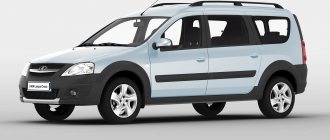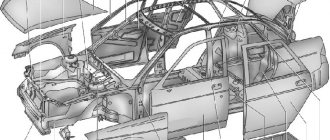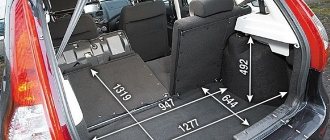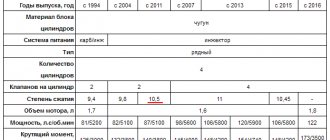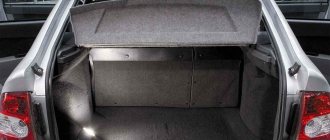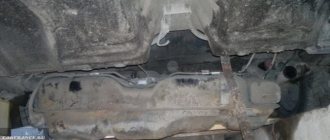On a regular Lada Largus van, the body dimensions are selected so that Euro pallets can be transported. We are talking not only about the space between the pillars, which are spaced 108 cm apart, but also about the distance between the wheel arches. It is 96 cm, and one pallet takes 80. The distance from the rear doors to the partition generally approaches two meters! A little more and it would have been possible to fit a couple of Euro pallets. Here we will look at how to remove the partition between the body and the cabin, and at the same time remove the inner bottom of the body. The first is needed for transporting long cargo, the second is also used for some reason.
We study the fastening of partitions and floors. Everything is shown in one video.
Linear dimensions of the cargo compartment of the Lada Largus van
All the sizes you need to know are shown in the photo. The van doors here are fixed at an angle of 90 degrees, but they can be opened all the way to 180. They are fixed in either of the two positions.
Luggage compartment of a Largus van
Let's list everything that is marked in the figure:
- The greatest height of the opening is 92 cm;
- Opening width – 108 cm;
- The distance “from arch to arch” is 96 cm;
- The distance from the edge of the threshold to the partition is 194 cm.
If you lay sheets diagonally, the width of the sheet should be less than 130 cm.
When the partition remains in place, the internal volume of the Lada Largus van is 2540 liters. Load capacity is 725 kg. These figures are indicated by AvtoVAZ.
In fact, the maximum lifting capacity exceeds a ton. It all depends on the road conditions and driving style.
Let's sum it up
The owners today have gained considerable experience in using LADA Largus in various fields and industries. They all nod their heads contentedly when asked about the convenience and practicality of the trunk. On the Internet you will find only a limitless mass of positive reviews about this model.
The size of the trunk turned out to be sufficient for the car to effectively demonstrate its functionality and be able to take the lead from competitors “touching on their heels.” The manufacturer managed to competently and rationally arrange the body space, which allows the station wagon to effectively cope with large objects, demonstrating an enviable carrying capacity. We definitely note that we recommend purchasing this station wagon for those who have not yet found a real “hard worker” as a companion, possessing a full range of balanced consumer and technical properties.
Video review of the LADA Largus luggage compartment:
Unfasten the partition or part of it
The partition separating the body and the cabin consists of two halves. They can be removed separately. Both parts are screwed to the body with screws designed for a 13mm key size. Of course, you need a socket wrench.
Screws 1 were hidden under the casing
The four screws on the left and right are located on the cab side. And to unscrew them, remove the casing.
All actions with cladding
The left part of the septum is removed after the right. To remove only the left half, first remove both, and then mount the right sash back. Based on this, immediately decide where you will remove the trim - only on the right or on both sides.
The volume of the body on the Lada Largus van cannot be greatly increased, even if the partition is completely removed. But without the partition, by removing the seat, it will be possible to transport loads 3 meters long.
So, let's start dismantling the trim: you need to remove the seat belt (key “17”), and then unscrew one self-tapping screw. A Torx T20 wrench is suitable for the self-tapping screw.
Active and passive safety systems Largus
Already in the base, the car is equipped with a driver’s airbag; the front passenger receives such protection only starting with the improved Norma Comfort package. By default, all cars are equipped with a rear door lock to prevent children from opening them. Active safety systems include ABS and an electronic brake force distribution system (EBD).
In 2013, a crash test of the car was carried out according to EEC rules, that is, a frontal impact on a barrier with 40% overlap at a speed of 56 km/h, and a side collision and a rear impact at a speed of 36 km/h were also simulated. The car coped with all the tests more than adequately. However, in tests using EuroNCAP methods, the station wagon scored only 8.32 points out of 16 possible.
Increasing the volume of the cargo compartment (removing the excess part on the floor)
The cargo compartment volume of the Lada Largus van can be increased. To do this, remove the floor covering.
There are two types of fasteners here
We will need special Torx keys, without which the screws cannot be unscrewed: Torx T30 and T40.
Study the picture carefully:
- T40 caps (2) are located at the corners, as well as on the line between the arches;
- The remaining screws (1) are designed for Torx T30 keys.
Removing the trim will be easy. And when you install it, make rubber gaskets. They are fixed to the ends of the frame so that the casing does not rust.
The removable floor (cladding) consists of two halves - left and right. First, according to tradition, the right one is removed.
Steering wheel, panel and door cards
The first thing that catches the driver's eye is the new steering wheel. To be precise, it’s not completely new, but exactly the same one could already be found on XRay and Vesta.
But it is worth noting that the steering wheel looks much nicer than the old one, feels good in the hands and, of course, its separate plus is the presence of additional control buttons, which will please many drivers.
The devices are combined in XRay and Vesta style and are represented by three wells, the rims of which are made to look like chrome.
As many people know, most Renault cars for the Russian market are assembled at AvtoVAZ facilities, which is the reason for the great similarity between some VAZ and Renault models.
By the way, the new Largus received updated headlights, which are very reminiscent of the Renault Logan headlights. The dashboard and door cards of the updated version are no exception and are taken from Renault Duster. The panel is made almost identical to the one used in Duster before its latest update.
And the door trim of the new Largus is so similar to the trim from Duster that it suggests that these are most likely the same cards. The glass control unit has also changed, and it is also taken from Duster.
Lada Largus technical specifications
Many potential car buyers are interested in the main technical characteristics of the Lada Largus. The car is a clone of the Dacia Logan MCV car of the Renault-Nissan alliance, which has gained some popularity in Europe, redesigned for domestic operating conditions. The Lada Largus model has similar technical characteristics. The car body type belongs to the category of high-capacity station wagons, and the dimensions of the Lada Largus allow the car to be classified both as spacious family cars and ultra-compact commercial vans.
Return to contents
Main body dimensions
The dimensions of the Lada Largus car differ little from those of its competitors, such as Fiat Doblo, Renault Kangoo, Peugeot Partner, Citroen Berlingo, Skoda Roomster, Volkswagen Caddy, Ford Connect Transit. The overall dimensions (body length/width/height) of the Peugeot Partner are 4380/1810/1800 mm, and the body dimensions of the Lada Largus are approximately the same.
Main dimensions of Lada Largus:
- length - 4470 mm;
- width - 1750 mm;
- height (including the dimensions of the roof rails) - 1670 mm;
- car base - 2900 mm;
- front track - 1469 mm;
- rear track - 1466 mm;
- front overhang - 795 mm;
- rear overhang - 770 mm;
- ground clearance under the lowest point of the engine - 145 mm;
- turning radius - 5.62 m.
The Lada Largus body has a hinged rear door. This ensures easy access to the luggage compartment, even in limited parking spaces. The left rear door leaf is noticeably wider than the right one, and the design of the car allows only it to be opened when loading and unloading.
Consumers care whether the Largus body is galvanized. It is known that all steel panels of the machine are double-sided galvanized.
Return to contents
Station wagon engine
The car comes with an 8-valve or 16-valve 4-cylinder fuel-injected engine with multiport fuel injection. The volume of these engines is 1598 cm3; cylinder diameter - 79.5 mm; piston stroke - 80.5 mm; compression ratio - 9.8. The 8-valve engine produces 90 horsepower and a torque of 128 N∙m. The maximum speed of Largus, equipped with such an engine, is 158 km/h, and acceleration to 100 km occurs in 13.4 s. The 16-valve engine is slightly more powerful, it produces 105 horsepower and a maximum torque of 148 N∙m. In this version, the maximum speed is 165 km/h, acceleration to 100 km is 11.8 s.
Lada Largus engines consume gasoline with an octane rating of 95. The car complies with Euro 4 standards. Lada Largus fuel consumption per 100 km in the combined cycle for a 5-seater version and a 16-valve engine is 11.5 liters, and on the highway - 7.6 liters per 100 km.
Features of the bodies of “Ladovo” models
Since we started with QOL, let’s continue this topic. For the frame of Ladovsky models without glued glass, the quality of life is 14 thousand N*m/degree, which is a very good mark. And with glass this figure is even higher.
https://youtube.com/watch?v=Pksaxx6I2BU
The testing of the Lada body in the rear turned out to be especially good. Thus, in the rear door opening, after a tough diagonal pressure test, the changes were recorded as only 1.5 mm, whereas on most foreign cars the same figure was 5-6 mm.
The body design of the Lada Largus and other similar models fundamentally complies with current European standards in terms of protecting passengers and the driver. The front subframe on Ladovsky models is one of the most important body elements responsible for this indicator. It is even considered an auxiliary spar, significantly increasing the strength of the body, as well as absorbing impact force.
VAZ overall body dimensions
The high quality of life of the Ladovsky body also has a beneficial effect on obtaining high-quality sound comfort in a car showroom. The frame does not twist over bumps and bumps, no deformations or anomalies occur between the interior and body elements, which ultimately has a positive effect on the absence of squeaks.
Note. Of course, in addition to the quality of life indicator, the quality of interior elements also affects the high level of sound comfort. They were obtained through proper calculation so as not to come into contact with the body in places where squeaking might occur. This was achieved by fixing the plastic components with special fasteners and minimizing the various gaps that arise one way or another between them and the body.
VAZ 2113 body dimensions
A lot of original parts, interchangeability of interior elements between Ladovsky models, enlargement of some parts of the body - all this was only a plus. In particular, the increase in some body elements led to a decrease in their number, which reduced production time and had a positive effect on performance.
Control dimensions of Lada Largus body geometry / Lada Largus
Dimensions of openings and clearances of mating parts of the LARGUS body
| A | B | IN | G | D | E | AND | 3 |
| 1380 ± 5 | 930 ± 4 | 1280 ± 5 | 1155 ± 15 | 925 ± 5 | 975 ± 5 | 1110 ± 5 | 610 ± 3 |
| AND | TO | L | M | N | ABOUT | P | |
| 795 ± 3 | 735 ± 3 | 1530 ± 5 | 800 ± 5 | 1380 ± 4 | 1030 ± 3 | 1140 ± 3 |
Mounting points for suspensions on the body
1 — front subframe mounting points; 2 — mounting points for the shock absorber strut; 3—rear subframe mounting points; 4 — guide holes of the front spar; 5 — front guides of the rear spar; 6 — guide holes for mounting the rear suspension; 7 — rear suspension mounting holes; 8 - holes for mounting the rear shock absorber; 9 — rear guide holes of the rear spar.
Scheme for measuring interaxial dimensions
Features of the bodies of “Ladovo” models
Since we started with QOL, let’s continue this topic. For the frame of Ladovsky models without glued glass, the quality of life is 14 thousand N*m/degree, which is a very good mark. And with glass this figure is even higher.
https://youtube.com/watch?v=Pksaxx6I2BU
The testing of the Lada body in the rear turned out to be especially good. Thus, in the rear door opening, after a tough diagonal pressure test, the changes were recorded as only 1.5 mm, whereas on most foreign cars the same figure was 5-6 mm.
The body design of the Lada Largus and other similar models fundamentally complies with current European standards in terms of protecting passengers and the driver. The front subframe on Ladovsky models is one of the most important body elements responsible for this indicator. It is even considered an auxiliary spar, significantly increasing the strength of the body, as well as absorbing impact force.
VAZ overall body dimensions
The high quality of life of the Ladovsky body also has a beneficial effect on obtaining high-quality sound comfort in a car showroom. The frame does not twist over bumps and bumps, no deformations or anomalies occur between the interior and body elements, which ultimately has a positive effect on the absence of squeaks.
Note. Of course, in addition to the quality of life indicator, the quality of interior elements also affects the high level of sound comfort. They were obtained through proper calculation so as not to come into contact with the body in places where squeaking might occur. This was achieved by fixing the plastic components with special fasteners and minimizing the various gaps that arise one way or another between them and the body.
VAZ 2113 body dimensions
A lot of original parts, interchangeability of interior elements between Ladovsky models, enlargement of some parts of the body - all this was only a plus. In particular, the increase in some body elements led to a decrease in their number, which reduced production time and had a positive effect on performance.
dimensions and dimensions in centimeters, length, width
LADA Largus has long won the sympathy of Russian car enthusiasts. Drivers often pay attention to the large trunk volume of the Lada Largus, which is considered the main advantage of this car. Domestic cars also cope well with another task - providing inexpensive and comfortable travel on modern roads. These two aspects and the ability to accommodate a large number of passengers allowed the car, produced at the Russian AvtoVAZ, to become a popular model in the CIS countries.
The dimensions of the Largus trunk depend on the body variation, it can be:
Cross
The smallest trunk size is in the Largus minivan, designed for 7 seats. The Largus Cross trunk reaches a volume of 200 liters. The manufacturer helped car owners by allowing them to increase the volume of the luggage compartment in liters to 1600–1800, for which two rows of seats should be removed.
The seven-seater version (minivan) has the most “modest” luggage compartment. But the manufacturer met his loyal customer halfway and endowed this modification with a simple secret: it is also possible to increase the luggage space to the same 1600–1800 liters by performing an identical operation to dismantle the stern seats. To do this, you will need to remove two planting rows.
Of course, neither a station wagon nor a minivan are designed to transport large loads, but if necessary, they will cope with this task perfectly.
Technical characteristics of Largus van. Lada Largus van body length
Dimensions of the Lada Largus 2018 van
Dimensions of the Lada Largus van
Russian sales of Lada Largus began in July 2012. The car is available in 7- and 5-seater versions, as well as in a van body.
The car has the following technical characteristics: 8 and 16 valve petrol engine with a volume of 1.6 liters and a power of 87 hp. and 106 hp
The Lada Largus 2022 van has dimensions: 4470 mm in length, 1750 mm in width and 1650 mm in height. The volume of the luggage compartment is 2540 liters.
New video review and test drive of the van:
The station wagon consumes only about 8.1 liters per 100 km in the combined cycle
Tire sizes are 185/70R14, 185/65R15.
See vehicle specifications and prices here.
Technical characteristics of Largus van / MirAvto Lada
Technical characteristics of the Lada Largus station wagon in numbers. For ease of loading, the rear door leaves are fixed in 3 positions 40, 90 and 180 degrees. To properly secure the load, there are 6 mounting points, allowing you to secure even small items. The Lada Largus is equipped with the well-known Renault 1.6 16 valve engines with a power of 102 hp. and 8 valve with a power of 87 hp, only 5 manual transmissions are available. The van's load capacity is 800 kg and the trunk volume is 2540 liters. In the crash test, Largus scored 3 stars out of 5.
Detailing of body parts
Note: For full details of the body with names and articles, see also the spare parts catalog here.
1. Front body panel; 2. Central bracket of the front body panel; 3. Lower outer front cross member
4. Front part of the front side member (partially); 5. Front spar cover; 6. Front subframe mount; 7. Front subframe mounting unit; 8. Towing eye; 9. Upper mudguard reinforcement; 10. Front part of the mudguard (partially); 11. Front part of the front wheel arch; 12. Engine mount support
13. Battery shelf; 14. Extreme side front cross member; 15. Wheel arch
1. Lower section of the body side 2. A-pillar; 3. Middle post; 4. Top side panel; 5. Front part of the sidewall; body; 6. Upper mudguard reinforcement; 7. Front double seal holder;
8. Partially rear part of the mudguard (front pillar trim); 9. Inner panel from the windshield opening pillar; 10. B-pillar upper inner panel; 11. Internal longitudinal; roof edge profile; 12. B-pillar amplifier; 13. Reinforcement of the lower section of the body side; 14. Lower inner trim of the B-pillar
15. Roof; 16. Front roof cross member; 17. Central cross section of the roof; 18. Roof reinforcement; 19. Rear roof cross member; 20.Front rear floor; 21. Front cross member of the rear floor section; 22. Trim for the lower section of the body side; 23. Side section of the central part of the floor; 24. Front cross member of the front seat; 25. Front seat mounting unit; 26. Front subframe rear mounting unit; 27. Front side cross member of the central floor section; 28. Lower cross member of the front panel; 29. Front shield; 30. Side reinforcement of the bulkhead; 31. Air intake niche wall; 32. Lower cross member of the windshield opening
1. Threshold cover; 2. Rear panel; 3. Rear light bracket; 4. Rear fender panel
5. Lowermost rear pillar; 6. Connecting element of the lower rear pillar; 7. Rear spar assembly (partial); 8. Rear towing eye; 9. Rear rear floor; 10. Rear floor rear cross member; 11. Outer rear wheel arch
12. Rear rear floor; 13. Rear spar assembly; 14. Rear wheel arch assembly; 15. Rear floor rear cross member; 16. Central cross member of the rear floor; 17. Rear cross member for mounting the fuel tank; 18. Rear floor front cross member front
Source of the article: https://largus-mcv.ru/html/detalirovka.html
Main disadvantages
Naturally, it’s difficult to talk about the shortcomings objectively, since everyone has different requirements, but it’s worth highlighting the main points that users don’t like the most:
- good sound insulation only in expensive versions;
- The seat heating control unit is inconveniently located;
- it is inconvenient to control the climate system;
- not very convenient control of the multimedia system;
- no front handles on the ceiling;
- The heating of the windshield does not cover the edges (the wipers do not cover them either).
Tuning
Dimensions of the Lada Vesta sedan (body dimensions, trunk and interior dimensions) The Lada Largus car turned out to be a practical model and from the start of sales it became a great success among car owners. The car has good build quality, but the appearance is not the best. The domestic car gave priority to rigor and practicality in favor of a stylish design. Therefore, many Lada Largus car owners will decide to improve their appearance using tuning.
Improving the power unit
When considering options for tuning a Lada Largus car, it is first advised to concentrate on the technical part
Special attention should be paid to the power unit. The “engine” can develop from 84 to 102 “horses”, depending on what design solutions are used in this car. For daily trips in an urban environment, the engine power is enough, especially if you have a family
But there are many Lada Largus owners who are not satisfied with the capabilities of their engine. Therefore, there are 2 ways to improve the power of your power plant:
For daily trips in an urban environment, the engine power is enough, especially if you have a family. But there are many Lada Largus owners who are not satisfied with the capabilities of their engine. Therefore, there are 2 ways to improve the power of your power plant:
- Perform chip tuning on the electronic control module, followed by changing the settings;
- To carry out modifications to the motor in the mechanical part, which involves productive intervention with the task - to replace the elements with similar components of a more reinforced plan.
If we talk about the first method - chip tuning, then it is quite common and is popular with many car owners. The purpose of the improvement is to change the ECU settings. As a result, it is possible to achieve engine adjustments. If you correctly calibrate certain parameters, you can expect a worthy reward - an increase in power.
Chip tuning is best done in specialized workshops. They can reprogram the standard firmware version to a different one. As a result:
- The fuel “appetite” decreases;
- Toxic emissions are reduced;
- Dynamic performance increases.
You can also resort to mechanical transformations of the power plant. This implies a significant improvement in performance (plus about 10-40 percent to the basic parameters). Such transformations are carried out by replacing some elements in the motor. This may include:
- Fuel supply system;
- Timing elements;
- Injection components;
- Elements of the cylinder-piston group and the block head.
Improvement of Largus body
If the owner of a Lada is not delighted with the appearance of the body, then you can transform the exterior of your “swallow”. Many people at this moment are inclined towards two options:
- Carry out structural modernization of body components;
- Make cosmetic improvements.
The first option involves replacing some body parts with newer ones. Often such elements receive an individual design
It is important that if you qualitatively and skillfully transform the exterior of the Lada Largus, you can improve its aerodynamics. Some drivers decide to:
- Installation of a spoiler;
- Installation of body kit on the hood;
- Replacement of front and rear optics with more modern ones;
- Installation of various reinforcing elements (front radiator grille, protective linings, skirts, etc.);
- Installation of newer “skating rinks”;
- Replacement of bumpers, external mirrors and other things.
Of course, such manipulations require the allocation of considerable funds and free time, but the result will please the owner for a long time. Simpler tuning includes cosmetic improvements to the exterior. Can:
- Renew body paint;
- Tint the windows;
- Make airbrushed designs on body panels;
- Glue the body with different polymer materials (carbon, vinyl, and so on);
- Use additional LED lighting sources.
Interior tuning
This may include:
- Replacing covers with new ones, with a more interesting design, or installing new seats instead of basic chairs;
- Covering panels with fresher materials;
- Replacing the “steering wheel” with similar options with a sporty twist;
- Installation of the armrest;
- Replacing door handles with similar ones with their own lighting;
- Application of noise insulation.
You can also install speakers, a subwoofer, a TV, etc., which increases the level of comfort. The improvement can also affect the suspension, through the use of reinforced parts, increasing or decreasing ground clearance, installing shock absorbers and stabilizers with increased data, etc.
